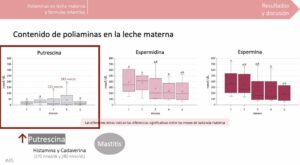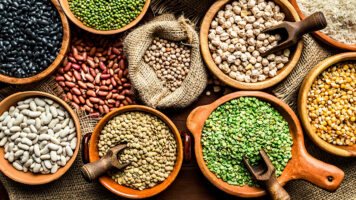Breast milk is the ideal food for all newborns and infants. Different organizations, such as the World Health Organization (WHO) or the Spanish Association of Pediatrics (AEP), exclusively recommend breastfeeding for the first six months of life, as do most of the world’s public organizations. However, it is important to note that it is not always possible and there are many respectable and justifiable reasons that can prevent it.
Breast milk contains several enzymes some of which are involved in the synthesis of milk in the mammary gland, while others are specific for the digestion of proteins, fats or carbohydrates, which facilitates the ability of the baby to take advantage of these main components of breast milk. In addition, it contains biologically active compounds: hormones, vitamins, cytokines and antibodies, as well as polyamines.
Polyamines are molecules with different effects in the body that can have an endogenous origin (from the body itself) or exogenous (through food). Breast milk is the primary source of polyamines in humans. These compounds are generally present in all living beings in the form of putrescine, spermidine and spermine.
Among other things, polyamines have been shown to play an important role in the functional maturation of the gastrointestinal tract during the neonatal period and the development of the baby’s immune system. In this way, food allergies in nursing babies can be prevented by decreasing the permeability of the mucosa to antigenic proteins.
One of the most studied polyamines in breast milk is putrescine, which requires the diamine oxidase (DAO) enzyme to be degraded like histamine. Scientific evidence shows a higher DAO activity in colostrum, as well as a decrease in its activity in mature breast milk (on day 30 of lactation), a fact that may be related to the need to degrade histamine during early lactation. Elevated levels of histamine have not been found in breast milk.
If you want us to advise you in a personalized way, either in our Barcelona nutrition centre or by video conference from anywhere in the world, contact us and we will help you
During pregnancy, there is an increase in the production of the DAO enzyme in most placentas from week 12 of gestation to create a metabolic barrier and prevent excessive entry of histamine into the fetus. When this natural effect arrives, women who suffer from migraine or other typical symptoms of histamine accumulation experience a glorious stage, are well and in most cases do not have to take drugs.
It should be noted that also have been reported cases in which the activity of the DAO enzyme does not increase, and, therefore, an accumulation of histamine occurs, resulting in certain gestational complications. Some of the complications, although rare, are premature rupture of the membranes, the appearance of uterine tumors and other disorders such as diabetes, abortions and premature births. For all these reasons, it is vital to control the levels of the enzyme during pregnancy, as well as the levels of histamine in plasma and urine.
We can even consider cases in which the mother also has mastitis (inflammation in the breast tissue that sometimes implies an infection). In this situation in which a histamine release occurs, that can “contaminate” the milk…
Would it be advisable to administer breast milk?
To this day, the evidence in this regard is very scarce and we find with numerous questions which we cannot yet give a closed and exact answer.

Slide #45 defense of the doctoral thesis of Nelly C. Muñoz Esparza. “Polyamines in food, breast milk and infant formulas.” 10 December 2021, University of Barcelona.
Fortunately, there are many infant milk formulas adapted for the correct development of the baby, being a great alternative to complement or replace breast milk when it is not possible to breastfeed. In this context, the knowledge of the bioactive compounds in breast milk and their beneficial effects has attracted the interest of researchers in the field of infant nutrition, as well as researchers in technology and food science to improve the nutritional characteristics of breast milk.
Bibliography
Almeida CC, Mendonça Pereira BF, Leandro KC, Costa MP, Spisso BF, Conte-Junior CA. Bioactive Compounds in Infant Formula and Their Effects on Infant Nutrition and Health: A Systematic Literature Review. Int J Food Sci. 2021 May 14;2021:8850080. doi: 10.1155/2021/8850080. PMID: 34095293; PMCID: PMC8140835.
Bjelakovic L, Kocic G, Bjelakovic B, Najman S, Stojanović D, Jonovic M, Pop-Trajkovic Z. Polyamine Oxidase and Diamine Oxidase Activities in Human Milk during the First Month of Lactation. Iran J Pediatr. 2012 Jun;22(2):218-22. PMID: 23056889; PMCID: PMC3446060.
Maintz L, Schwarzer V, Bieber T, van der Ven K, Novak N. Effects of histamine and diamine oxidase activities on pregnancy: a critical review. Hum Reprod Update. 2008 Sep-Oct;14(5):485-95. doi: 10.1093/humupd/dmn014. Epub 2008 May 22. PMID: 18499706.







Thank you for this interesting post. I am currently one of your clients, and I have just been diagnosed with genetic DAO defficiency.
Actually, I didn’t arrive to histamine intolerance due to my symptons (which I also suffer), but my two breastfed daughters. Both of them showed pseudoallergic reactions (bloody stools, ciclic vomiting, skin rash, fuzzyness,…) starting between 3 and 5 months. They were exclusively breastfed, so doctors recommended me restricting my diet with common allergens (cow’s milk, fish, eggs, etc.), without great success, as my daughters kept having these symptoms. So, now that my second daughter started experimenting the same symptoms, I was sure that it should be either some genetic issue or something related to my breastmilk. I reached you thanks to an article in the “Asociación Española de Intolerancias Alimentarias y Microbiota” about DAO defficiency, and after starting a low-histamine diet, my 6 month-old baby has improved significantly, which confirms that my breastmilk was not the best food for my baby. I wished they had told me earlier and prevent my two daughters from suffering from it, because doctors kept telling me that breastfeeding was the best thing I could do anyway.
I hope that more research is carried out in this area, so babies or/and mothers with histamine intolerance know how to proceed and get the necessary support during such a frail period of time (0-1 year old). I personally offer myself as a research subject if needed. 🙂
Thank you for your work and for posting these relevant pieces of information based on scientific evidence.
Hola Eukene,
Many thanks to you for your post.
With Hélène you are in good hands.
Regards!
Hi! Did you also test your children? Do they also have DAO deficiency?